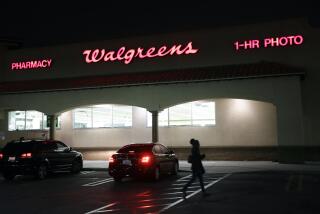Two years in, Amazon has hardly launched a revolution at Whole Foods
- Share via
This weekend will mark two years since Amazon.com Inc. announced it was acquiring Whole Foods Market. It was a thunderclap that demonstrated Amazon’s ever-growing ambitions and all but assured that e-commerce was about to rattle one of the last corners of retail to remain insulated from digital transformation.
By now, Amazon’s fingerprints on Whole Foods are clear. It has expanded grocery delivery and online ordering into dozens of Whole Foods stores, cut prices on select items and offered discounts for Prime members.
Those pricing moves appear to have changed people’s attitudes. YouGov, which surveys shoppers about consumer brands, has found that Whole Foods’ value perception has improved meaningfully in the past two years, showing Amazon has chipped away at the “Whole Paycheck” reputation that had hurt the grocer as rivals perceived as more price-conscious, including Kroger Co. and Walmart Inc., embraced organic food.
By broadening online shopping options and selectively slashing prices, Amazon showed it could execute in groceries the playbook we already know it has mastered. But what about untested things such as in-store merchandising, customer experience and labor allocation? On these merits, let’s be honest: Whole Foods still basically feels like the same old Whole Foods.
Amazon’s lack of imagination at Whole Foods is something we’ve seen repeatedly as the e-commerce giant experiments with physical stores. Amazon’s bookstores aren’t that different from conventional shops. Its 4-star knickknack stores are Hallmark gift stores crossed with Brookstone.
Amazon recently shuttered dozens of mall kiosks where it sold Kindle tablets and other electronics. Those Amazon formats, and those of companies such as Kohl’s Corp. with which Amazon has an in-store partnership, sometimes seem to exist largely as outposts for people to return unwanted Amazon orders.
From Amazon’s earliest years, Chief Executive Jeff Bezos has said that the company was interested in operating physical stores, but only if it had unique ideas. Apart from Amazon’s experimental cashier-less convenience stores, none of its other brick-and-mortar experiences live up to that promise.
Amazon executives have used the word “invention” to describe what the company has done at Whole Foods, but that is a generous assessment.
In addition to expanding home delivery or in-person pick-up of online grocery orders, Amazon has enmeshed its brand more with Whole Foods’. People can buy Whole Foods products on Amazon, use an Amazon-branded credit card to rack up rewards, pick up Amazon packages at lockers inside Whole Foods locations, and use the Alexa digital assistant to start a Whole Foods order.
Amazon says that “the goal has always been to make consistent, smaller innovations over time” to expand the Whole Foods mission of organic and quality food.
It takes time to change an established store chain, and there may be a broader vision for groceries that Amazon hasn’t articulated. In fact, it’s surprising just how little Amazon has said about why it purchased Whole Foods, what it has changed under the hood or future plans for its jumble of food offerings. There may be no other public company that could spend more than $13 billion to expand into a completely new business, and tell investors little about what it was doing or why.
Shoppers haven’t been bowled over, either. Despite the changing feelings about Whole Foods prices, YouGov data shows that U.S. consumers’ willingness to consider purchasing at Whole Foods has settled right around where it was at the time the deal was announced.
Amazon also hasn’t been transparent about what financial improvements, if any, have resulted from its ownership of Whole Foods. Amazon’s reported revenue from its physical stores, which is principally Whole Foods, posted a 2.7% decline in the fourth quarter of 2018 from a year earlier and a 1% increase in the first quarter. That’s slower than comparable Whole Foods quarterly revenue growth before the acquisition.
Food seems to be a category that keeps bedeviling Amazon. It said last week it will close its 4-year-old restaurant food delivery operation in the U.S., an admission that it had been outgunned by Grubhub Inc., Doordash and Uber Eats. It earlier pared back the footprint of its 12-year-old Amazon Fresh grocery-delivery service, which struggled long before Whole Foods was in its tent.
Amazon won’t give up fighting for a much larger share of the more than $800 billion Americans spend on food shopping every year, and Whole Foods was a big bet that physical stores remain key to cracking that market. What Amazon has done so far is to Amazon-ify Whole Foods in necessary but also obvious ways. What’s perhaps surprising is that two years in, there have been few glimpses of new ideas that Amazon could bring to supermarket shopping.
More to Read
Inside the business of entertainment
The Wide Shot brings you news, analysis and insights on everything from streaming wars to production — and what it all means for the future.
You may occasionally receive promotional content from the Los Angeles Times.










